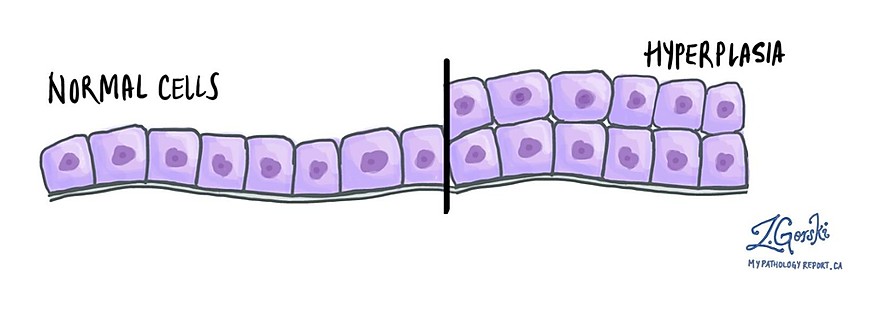Hyperplasia is a non-cancerous condition characterized by an increased number of cells within a tissue or organ. This increase in cell number can cause the affected tissue to grow larger or thicker. Hyperplastic is another term commonly used to describe tissues that have undergone hyperplasia. This change can only be seen when the tissue is examined under a microscope.
Types of hyperplasia
Hyperplasia can occur in almost any part of the body. Specific names are often given to hyperplasia depending on the location or appearance of the cells involved:
-
Breast: Usual ductal hyperplasia describes an increase in normal-appearing cells within breast ducts.
-
Colon: A Hyperplastic polyp is a non-cancerous growth within the colon lining.
-
Endometrium (lining of the uterus): Endometrial hyperplasia without atypia involves an increased number of normal-appearing cells in the uterine lining.
Is hyperplasia a type of cancer?
No, hyperplasia is not cancer. However, some types of hyperplasia contain abnormal-looking cells, referred to as atypical cells, and these types carry a higher risk of developing into cancer over time.
Common precancerous forms of hyperplasia include:
-
Breast: Atypical ductal hyperplasia and atypical lobular hyperplasia.
-
Endometrium: Atypical endometrial hyperplasia.
It is important to monitor and sometimes treat these precancerous conditions to reduce the risk of developing cancer.
What causes hyperplasia?
The cause of hyperplasia depends on the location in the body:
-
Hormonal stimulation: Excess or prolonged exposure to hormones often causes hyperplasia in tissues such as the breast, prostate, and endometrium (uterus lining).
-
Chronic irritation or stress: Physical stress or irritation can trigger hyperplasia, such as hyperplastic polyps in the colon.
Identifying the cause of hyperplasia helps guide appropriate treatment and management.
Hyperplasia versus hypertrophy
Both hyperplasia and hypertrophy result in tissue enlargement, but they differ significantly:
-
Hyperplasia: Increased tissue size due to a greater number of cells.
-
Hypertrophy: Increased tissue size due to individual cells becoming larger, with no increase in cell number.
How do pathologists identify hyperplasia?
Pathologists diagnose hyperplasia by examining tissue samples under a microscope. They look for an increased number of cells and determine if these cells appear normal (non-atypical) or abnormal (atypical). This distinction helps guide further management and follow-up.
Is treatment necessary for hyperplasia?
Whether treatment is required depends on the type and location of hyperplasia:
-
Non-atypical hyperplasia often does not require treatment but may need monitoring.
-
Atypical hyperplasia frequently requires more active management, such as closer surveillance or surgical removal, to prevent progression to cancer.
Questions to ask your doctor
-
Where in my body is hyperplasia present?
-
Is the hyperplasia considered precancerous (atypical), or is it non-atypical?
-
What caused the hyperplasia, and should I make any lifestyle changes?
-
Do I require any treatment, or is monitoring sufficient?
-
What follow-up or screening will I need?




